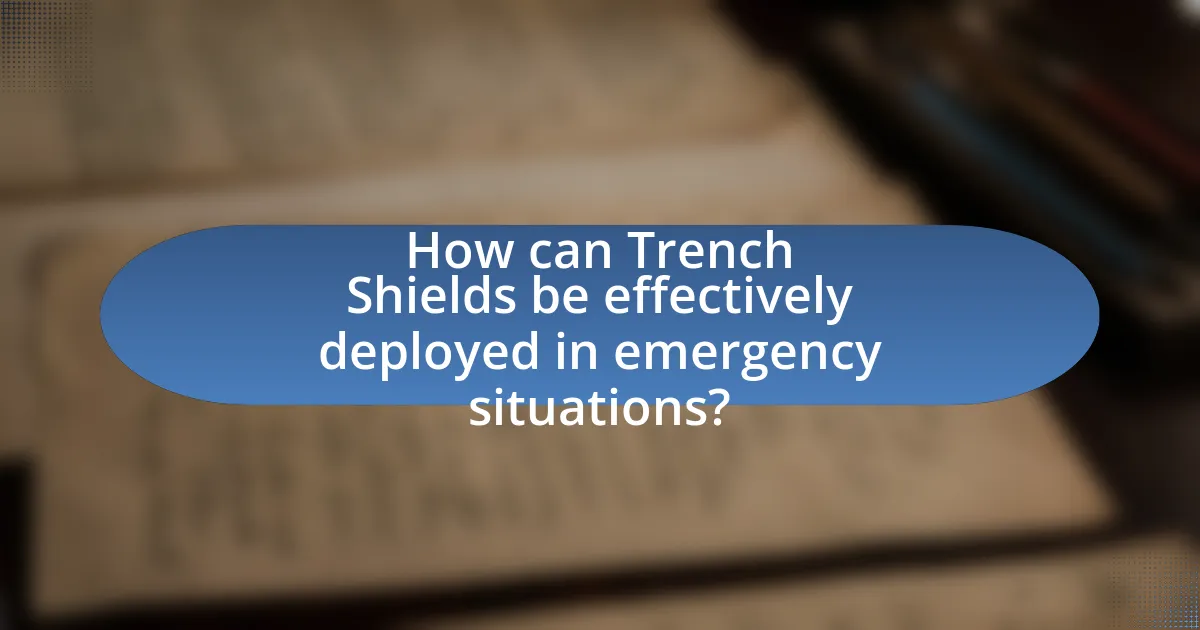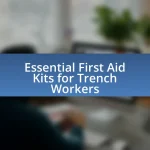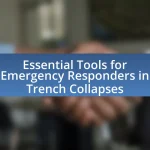Trench shields are essential protective structures used in excavation sites to prevent soil collapse and safeguard workers from hazards, particularly in emergency situations. This article outlines the importance of trench shields, their functionality, and the materials commonly used in their construction. It also discusses key regulations governing their use, the various types available, and best practices for effective deployment and maintenance during emergencies. Additionally, the article highlights the challenges associated with trench shield usage and emphasizes the significance of training and communication in enhancing safety outcomes.

What are Trench Shields and Why are They Important in Emergency Situations?
Trench shields are protective structures used in excavation sites to prevent soil collapse and protect workers from potential hazards. They are crucial in emergency situations because they provide immediate safety by stabilizing the walls of trenches, thereby reducing the risk of cave-ins, which can lead to serious injuries or fatalities. According to the Occupational Safety and Health Administration (OSHA), trench collapses account for a significant number of construction-related deaths, emphasizing the importance of using trench shields to ensure worker safety during excavation activities.
How do Trench Shields function in protecting workers?
Trench shields function by providing a protective barrier that prevents soil collapse during excavation work, thereby safeguarding workers from potential injuries or fatalities. These shields are designed to withstand the lateral pressure exerted by the surrounding soil, which can be particularly hazardous in unstable ground conditions. According to the Occupational Safety and Health Administration (OSHA), trench shields must meet specific engineering standards to ensure they effectively protect workers in trenches deeper than five feet. By using trench shields, employers can significantly reduce the risk of cave-ins, which are a leading cause of construction-related fatalities.
What materials are commonly used in Trench Shields?
Trench shields are commonly made from steel, aluminum, and polymer materials. Steel is favored for its strength and durability, making it suitable for heavy-duty applications. Aluminum offers a lighter alternative while still providing adequate protection, and polymer materials are increasingly used for their corrosion resistance and lightweight properties. These materials ensure that trench shields can effectively support the surrounding soil and protect workers from cave-ins, which is critical in emergency situations.
How do design features enhance the effectiveness of Trench Shields?
Design features enhance the effectiveness of trench shields by providing structural integrity and stability, which are critical for worker safety in excavation sites. For instance, features such as reinforced edges and interlocking panels prevent soil collapse and ensure that the shield can withstand lateral earth pressures. Additionally, lightweight materials facilitate easier handling and installation, allowing for quicker deployment in emergency situations. The incorporation of safety features like built-in ladders and access points further improves usability, enabling workers to enter and exit safely. These design elements collectively contribute to reducing the risk of accidents and injuries, thereby enhancing overall operational efficiency in emergency scenarios.
What are the key regulations governing the use of Trench Shields?
The key regulations governing the use of trench shields include the Occupational Safety and Health Administration (OSHA) standards, specifically 29 CFR 1926.650-652, which outline requirements for excavation safety. These regulations mandate that trench shields must be designed to protect workers from cave-ins and must be used in accordance with manufacturer specifications. Additionally, the American National Standards Institute (ANSI) provides guidelines for the design and use of trench protective systems, ensuring that they meet safety criteria. Compliance with these regulations is essential for minimizing risks associated with trench work, as they are based on extensive research and industry best practices aimed at safeguarding workers’ health and safety.
Which organizations set the standards for Trench Shield usage?
The organizations that set the standards for Trench Shield usage include the Occupational Safety and Health Administration (OSHA) and the American National Standards Institute (ANSI). OSHA provides regulations that ensure safety in excavation and trenching operations, while ANSI develops consensus standards that guide the design and performance of trench shields. These organizations establish guidelines that are critical for minimizing risks associated with trenching activities, thereby enhancing worker safety.
How do these regulations impact emergency response protocols?
Regulations significantly enhance emergency response protocols by establishing safety standards and procedures that protect workers during trenching operations. These regulations, such as those set forth by the Occupational Safety and Health Administration (OSHA), mandate the use of trench shields to prevent cave-ins, thereby reducing the risk of injury or fatalities. For instance, OSHA’s standard 1926.652 requires protective systems for trenches deeper than five feet, which directly influences how emergency responders prepare for and manage incidents involving trench collapses. By adhering to these regulations, emergency response teams can implement more effective rescue strategies, ensuring that they have the necessary equipment and training to respond safely and efficiently in high-risk situations.
What are the common types of Trench Shields used in emergencies?
Common types of trench shields used in emergencies include hydraulic trench boxes, modular trench shields, and trench plates. Hydraulic trench boxes are designed to provide support and protection in deep excavations, often adjustable to various depths. Modular trench shields are versatile and can be assembled in different configurations to suit specific site requirements. Trench plates, typically made of steel or aluminum, are used to cover excavations and provide a safe surface for traffic while protecting workers below. These types of trench shields are essential for ensuring safety and stability during emergency excavation work.
What distinguishes a standard Trench Shield from a modular one?
A standard Trench Shield is a single, rigid unit designed for specific trench dimensions, while a modular Trench Shield consists of multiple interlocking panels that can be configured to fit various trench sizes and shapes. The standard design limits flexibility, making it suitable for consistent trench depths, whereas the modular design allows for adaptability in diverse excavation scenarios. This adaptability is crucial in emergency situations where trench dimensions may vary, ensuring safety and compliance with regulations.
How do different types of Trench Shields cater to various emergency scenarios?
Different types of trench shields are designed to address specific emergency scenarios by providing varying levels of protection and support based on the conditions encountered. For instance, lightweight trench shields are ideal for shallow excavations where quick deployment is necessary, while heavy-duty shields are suited for deeper trenches that require enhanced stability against soil pressure and potential collapses. Additionally, modular trench shields allow for customization in size and configuration, making them versatile for different site conditions and emergency responses. The effectiveness of these shields is supported by industry standards, such as those outlined by the Occupational Safety and Health Administration (OSHA), which emphasize the importance of using appropriate protective measures based on trench depth and soil type to prevent accidents and ensure worker safety.

How can Trench Shields be effectively deployed in emergency situations?
Trench shields can be effectively deployed in emergency situations by ensuring proper installation and adherence to safety protocols. Proper installation involves placing the trench shield securely in the excavation site to prevent soil collapse, which is critical in emergencies where time is limited. Adhering to safety protocols includes conducting a risk assessment before deployment, ensuring that the shield is appropriate for the soil type and depth, and training personnel on its use. According to the Occupational Safety and Health Administration (OSHA), using trench shields can reduce the risk of cave-ins by providing a protective barrier, thus enhancing worker safety during urgent operations.
What are the best practices for setting up Trench Shields?
The best practices for setting up trench shields include ensuring proper alignment, securing the shields against movement, and verifying soil conditions. Proper alignment involves placing the shields parallel to the trench walls to maximize stability. Securing the shields can be achieved by using appropriate anchoring methods to prevent shifting during excavation. Additionally, assessing soil conditions is crucial, as unstable or saturated soils may require additional support measures to ensure the safety of the trench. These practices are supported by guidelines from organizations such as the Occupational Safety and Health Administration (OSHA), which emphasizes the importance of proper installation and maintenance of trench safety systems to prevent collapses and protect workers.
How should the site be prepared before deploying a Trench Shield?
The site should be prepared by ensuring proper excavation and soil assessment before deploying a Trench Shield. This involves evaluating the soil type, checking for underground utilities, and ensuring the trench walls are stable. According to OSHA regulations, a competent person must inspect the site to identify hazards and ensure compliance with safety standards. Proper site preparation minimizes risks associated with trench collapses and enhances the effectiveness of the Trench Shield.
What safety checks should be performed prior to use?
Prior to using trench shields in emergency situations, it is essential to perform several safety checks to ensure the equipment’s integrity and the safety of personnel. First, inspect the trench shield for any visible damage, such as cracks or dents, which could compromise its structural integrity. Second, verify that all locking mechanisms are functioning correctly to prevent accidental movement during use. Third, check for proper installation and alignment of the trench shield within the trench to ensure stability. Additionally, assess the surrounding area for potential hazards, such as overhead utilities or unstable soil conditions, which could pose risks during operation. These checks are critical as they help prevent accidents and ensure compliance with safety regulations, such as those outlined by the Occupational Safety and Health Administration (OSHA).
How can Trench Shields be maintained during emergency operations?
Trench shields can be maintained during emergency operations by conducting regular inspections, ensuring proper installation, and performing necessary repairs. Regular inspections involve checking for signs of wear, damage, or structural integrity issues, which helps identify potential failures before they occur. Proper installation ensures that the trench shields are securely positioned and adequately supported, reducing the risk of collapse. Additionally, performing repairs on any identified damage promptly maintains the effectiveness of the shields. These practices are essential for ensuring the safety of workers and the stability of the excavation site during emergency situations.
What routine inspections are necessary for Trench Shields in use?
Routine inspections necessary for trench shields in use include checking for structural integrity, ensuring proper installation, and verifying that all safety features are functional. Structural integrity assessments involve examining for any signs of wear, damage, or deformation that could compromise the shield’s effectiveness. Proper installation checks ensure that the trench shield is positioned correctly and securely, preventing any potential collapse. Additionally, verifying that safety features, such as locking mechanisms and warning labels, are operational is crucial for maintaining safety standards. These inspections are essential to comply with OSHA regulations, which mandate regular safety checks to prevent accidents and ensure worker safety in excavation sites.
How can wear and tear be identified and addressed promptly?
Wear and tear can be identified and addressed promptly by conducting regular inspections and maintenance of trench shields. Regular visual checks for cracks, rust, or deformation, along with scheduled maintenance, ensure that any signs of wear are detected early. For instance, the Occupational Safety and Health Administration (OSHA) recommends inspecting equipment before each use to identify potential issues that could compromise safety. Addressing identified wear through timely repairs or replacements prevents accidents and maintains the integrity of the trench shields during emergency situations.

What challenges might arise when using Trench Shields in emergencies?
Challenges that might arise when using trench shields in emergencies include limited space for installation, potential for equipment failure, and the need for rapid deployment. Limited space can hinder the effective placement of trench shields, especially in confined or cluttered environments, which may compromise worker safety. Equipment failure can occur due to the high-stress conditions of emergencies, leading to inadequate protection against soil collapse. Additionally, the urgency of emergency situations often necessitates quick setup, which can result in improper installation if not executed correctly, increasing the risk of accidents. These challenges highlight the importance of thorough training and preparedness in emergency response scenarios involving trench shields.
What are the common pitfalls to avoid when using Trench Shields?
Common pitfalls to avoid when using trench shields include improper installation, neglecting soil conditions, and failing to conduct regular inspections. Improper installation can lead to shield failure, as the shields must be correctly positioned and secured to withstand lateral soil pressure. Neglecting soil conditions can result in inadequate support; for instance, saturated or unstable soil can compromise the effectiveness of the shields. Regular inspections are crucial, as they help identify wear, damage, or shifting that could jeopardize safety. According to the Occupational Safety and Health Administration (OSHA), adherence to these practices is essential for ensuring worker safety in excavation sites.
How can improper installation lead to safety hazards?
Improper installation of trench shields can lead to safety hazards such as collapses, which can result in serious injuries or fatalities. When trench shields are not correctly positioned or secured, they may fail to provide adequate support to the surrounding soil, increasing the risk of cave-ins. According to the Occupational Safety and Health Administration (OSHA), approximately 75% of trench-related fatalities occur in collapses, highlighting the critical importance of proper installation. Additionally, inadequate installation can compromise the structural integrity of the shield, leading to equipment damage and further jeopardizing worker safety.
What are the consequences of neglecting maintenance on Trench Shields?
Neglecting maintenance on trench shields can lead to severe safety hazards, including structural failure and increased risk of accidents. When trench shields are not properly maintained, they may develop weaknesses or defects that compromise their ability to protect workers from cave-ins or falling debris. According to the Occupational Safety and Health Administration (OSHA), proper maintenance is essential to ensure that trench shields meet safety standards and function effectively. Failure to adhere to maintenance protocols can result in costly injuries, legal liabilities, and project delays, emphasizing the critical importance of regular inspections and repairs.
How can training improve the effectiveness of Trench Shield usage?
Training enhances the effectiveness of Trench Shield usage by equipping personnel with the necessary skills and knowledge to operate the equipment safely and efficiently. Proper training ensures that workers understand the correct installation, maintenance, and emergency procedures associated with trench shields, which significantly reduces the risk of accidents and injuries. For instance, studies show that organizations that implement comprehensive training programs experience a 30% reduction in workplace incidents related to trenching operations. This evidence underscores the importance of training in fostering a culture of safety and competence, ultimately leading to more effective use of trench shields in emergency situations.
What key skills should emergency responders develop regarding Trench Shields?
Emergency responders should develop skills in proper installation, assessment of soil conditions, and understanding of safety regulations regarding trench shields. Proper installation skills ensure that trench shields are set up correctly to prevent collapses, which is critical in maintaining the safety of personnel working in or near trenches. Assessing soil conditions is essential, as different soil types can affect the stability of trenches and the effectiveness of the shields. Understanding safety regulations, such as those outlined by the Occupational Safety and Health Administration (OSHA), is vital for compliance and ensuring the safety of all involved in emergency situations. These skills collectively enhance the effectiveness of trench shields in protecting responders during operations.
How often should training sessions be conducted for personnel?
Training sessions for personnel should be conducted at least annually to ensure compliance with safety standards and effective use of trench shields in emergency situations. Regular training helps reinforce knowledge and skills, as studies indicate that annual refreshers can significantly reduce accidents and improve response times. For instance, the Occupational Safety and Health Administration (OSHA) recommends frequent training to maintain safety awareness and competency among workers handling trench shields.
What practical tips can enhance the use of Trench Shields in emergencies?
To enhance the use of Trench Shields in emergencies, ensure proper installation and regular inspection of the shields before deployment. Proper installation involves placing the shields in a way that they are securely anchored and aligned with the trench walls to prevent collapse. Regular inspections should check for any signs of wear, damage, or shifting that could compromise their effectiveness. According to OSHA regulations, using trench shields that meet safety standards significantly reduces the risk of cave-ins, which can be fatal. Additionally, training personnel on the correct use and maintenance of trench shields can further improve safety outcomes during emergency situations.
How can effective communication improve safety when using Trench Shields?
Effective communication enhances safety when using trench shields by ensuring that all team members are aware of their roles, potential hazards, and safety protocols. Clear instructions and regular updates during operations minimize misunderstandings, which can lead to accidents. For instance, a study by the National Institute for Occupational Safety and Health (NIOSH) highlights that effective communication reduces the risk of injuries in construction environments by 30%. This statistic underscores the importance of maintaining open lines of communication among workers, supervisors, and safety personnel to facilitate timely responses to any emerging risks while using trench shields.
What resources are available for ongoing education about Trench Shields?
Ongoing education about Trench Shields can be accessed through various resources including industry-specific training programs, online courses, and safety organizations. The National Utility Contractors Association (NUCA) offers training sessions focused on trench safety and shield usage, while the Occupational Safety and Health Administration (OSHA) provides guidelines and resources for safe excavation practices. Additionally, manufacturers of trench shields often provide educational materials and workshops to ensure proper usage and compliance with safety standards. These resources are essential for staying updated on best practices and regulatory requirements in emergency situations involving trench shields.


